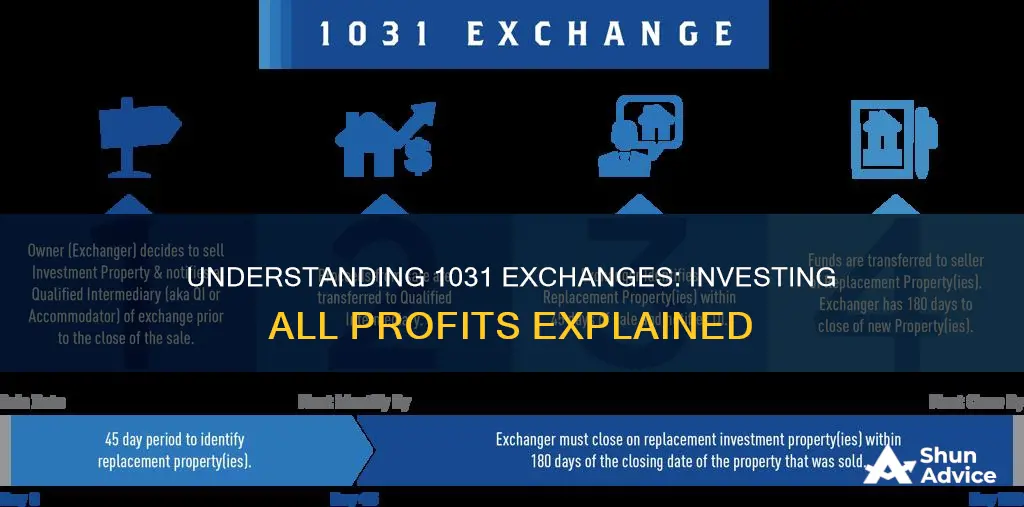
A 1031 exchange, also known as a like-kind exchange or Starker exchange, is a powerful tool for real estate investors to defer or eliminate capital gains taxes when selling and buying properties. By exchanging one investment property for another of similar type, investors can roll over their profits and defer taxes until they eventually sell the new property for cash. This strategy, named after Section 1031 of the Internal Revenue Code, has been a valuable method for investors to build wealth more quickly and diversify their portfolios. While there are specific rules and time constraints to follow, such as using a qualified intermediary to handle funds and identifying replacement properties within 45 days, the 1031 exchange offers significant tax advantages for real estate investors.
| Characteristics | Values |
|---|---|
| What is a 1031 exchange? | A swap of one real estate investment property for another that allows capital gains taxes to be deferred. |
| Who can use it? | Real estate investors, individuals or entities. |
| What type of properties qualify? | Business or investment properties. Both properties must be located in the United States. |
| What are the requirements? | The properties must be "like-kind", meaning they are of the same nature, character or class. The investor must identify the replacement property within 45 days and acquire it within 180 days. |
| What are the benefits? | Deferring capital gains taxes, diversifying one's portfolio, and building wealth more quickly. |
| What are the potential drawbacks? | If the exchange is done too quickly or the investor trades many properties in a year, they may be considered a "dealer" and disqualified from the exchange. Taking personal receipt of the proceeds of the original sale will also trigger capital gains tax liability. |
| What are some examples? | Exchanging a small apartment building for a larger apartment project, an office building, or vacant land. |
What You'll Learn

What is a 1031 exchange?
A 1031 exchange, also known as a like-kind exchange or Starker exchange, is a provision under Section 1031 of the Internal Revenue Code (IRC) that allows investors to swap one real estate investment property for another while deferring capital gains taxes. This strategy has been permitted under the IRC since 1921 to encourage active reinvestment and avoid taxation on ongoing property investments.
To qualify as a 1031 exchange, both the original and replacement properties must be located in the United States and held for productive use in a trade, business, or investment. The properties involved in the exchange must be of the same nature, character, or class, but they do not need to be of the same quality or grade. For example, a real estate investor can exchange a small apartment building for a larger apartment project, an office building, or vacant land. It is important to note that primary residences do not typically qualify for a 1031 exchange unless a portion of the residence is used for trade, business, or investment purposes.
There are specific rules and time constraints associated with 1031 exchanges. Investors must identify the replacement property within 45 days of selling the original property and must complete the purchase within 180 days. Additionally, investors should be cautious about exchanging properties too frequently or too quickly after acquisition, as they may be considered "'dealers' and their properties may be viewed as stock in trade, which does not qualify for a 1031 exchange.
By utilizing a 1031 exchange, investors can defer taxes until they eventually sell the property for cash, allowing them to build wealth more quickly. This strategy can also help investors diversify their portfolios and stay more liquid by redeploying capital gains to scale their real estate investments. However, it is important for investors to carefully follow the rules and regulations associated with 1031 exchanges to maximize the benefits of these swaps.
Investing Together, Retiring Together: A Couple's Guide to Financial Freedom
You may want to see also

How does a 1031 exchange work?
A 1031 exchange, also known as a like-kind exchange or Starker exchange, is a provision in the US Internal Revenue Code (IRC) that allows investors to defer or avoid capital gains taxes when swapping one investment property for another of similar type. This strategy has been permitted under the IRC since 1921 to encourage active reinvestment and avoid taxation on ongoing property investments.
To perform a 1031 exchange, investors must follow a series of strict rules and regulations. Firstly, the properties exchanged must be of the same nature, character, or class, although the quality or grade of the properties does not matter. The properties must also be located in the United States to qualify for a 1031 exchange. Additionally, there are specific time constraints for these exchanges. Investors have 45 days to identify potential replacement properties and 180 days to purchase the new property. It is important to note that taking personal receipt of the proceeds of the original sale will trigger capital gains tax liability, and investors should instead use a qualified intermediary to handle the funds.
By utilising a 1031 exchange, investors can benefit from tax deferral, diversification, and the ability to reinvest proceeds into a like-kind investment. This allows investors to build wealth more quickly and stay more liquid by redeploying capital gains to scale their real estate portfolios.
It is worth noting that certain properties are excluded from 1031 exchanges, including stocks, bonds, notes, securities, interests in partnerships, and property held "primarily for sale". Additionally, primary residences typically do not qualify for an exchange unless a portion of the property is used for trade, business, or investment purposes.
Pay Off Debt or Invest: Navigating the Financial Crossroads
You may want to see also

What are the rules of a 1031 exchange?
A 1031 exchange, also known as a like-kind exchange or Starker exchange, is a provision under Section 1031 of the Internal Revenue Code (IRC) that allows investors to swap one real estate investment property for another while deferring capital gains taxes. Here are the key rules to understand:
- Property Eligibility: The properties involved in the exchange must be like-kind, meaning they are of a similar nature or type. This typically applies to real estate investment properties, but it can also include business exchanges under certain conditions. Both properties must be located in the United States.
- Timing Rules: There are strict timing constraints associated with a 1031 exchange. Once the initial property is sold, there is a 45-day identification period during which the investor must identify potential replacement properties. The investor can nominate up to three properties of any value and must ultimately acquire one or more of them within 180 days.
- Qualified Intermediary (QI): A critical component of a 1031 exchange is the involvement of a Qualified Intermediary (QI). The QI is an independent third party that holds the sale proceeds, prepares the necessary documentation, and ensures compliance with IRS regulations. The QI disburses funds for the purchase of the replacement property and returns any unused funds to the taxpayer.
- Tax Implications: While a 1031 exchange allows for the deferral of capital gains taxes, there are still potential tax consequences. If the new property is of lesser value than the old one, the investor may have to pay taxes on the unused capital gains, known as "boot." Additionally, depreciation recapture taxes may apply if improved land with a building is exchanged for unimproved land without a building.
- Intent and Holding Period: The IRS scrutinizes the intent behind the property exchange. The properties should be held for investment purposes, and renting out the property at a fair market value can support this intention. While there is no designated holding period, seasoning the property as an investment for at least one year before moving into it is generally recommended.
- Vacation Homes and Personal Property: The rules regarding vacation homes and personal property have become more stringent. To qualify for a 1031 exchange, a vacation home must be converted into a rental property, and the owner must conduct themselves in a business-like manner. Personal property, such as franchise licenses, aircraft, and equipment, generally no longer qualifies for a 1031 exchange.
Life Insurance or Investments: Where Should Your Money Go?
You may want to see also

What are the benefits of a 1031 exchange?
A 1031 exchange, also known as a like-kind exchange or Starker exchange, offers several benefits for investors looking to optimise their real estate portfolios. Here are some advantages to consider:
Tax Deferral
The primary benefit of a 1031 exchange is the ability to defer capital gains taxes. When investors sell a property, they typically incur capital gains tax on the profits. However, with a 1031 exchange, they can reinvest all the proceeds from the sale into a new property, postponing the tax liability to a later date. This strategy allows investors to use their full profits to acquire larger or more valuable properties, increasing their purchasing power and potential for wealth accumulation.
Increased Cash Flow and Income
By exchanging a property with low cash flow or depreciation benefits for one that generates higher returns, investors can improve their cash flow and overall income. For example, exchanging a vacant plot of land for a commercial building can result in higher rental income and better financial performance.
Portfolio Diversification
A 1031 exchange enables investors to diversify their real estate portfolios. They can exchange an existing property for one with better long-term prospects or for properties in different locations or asset classes. This diversification can help spread risk and maximise the potential for returns.
Improved Property Management
Through a 1031 exchange, investors can exchange a property they manage on their own for an already-managed property. This can reduce the time and effort required for property management, especially if they own multiple properties.
No Limit on Frequency
There is no restriction on how often investors can perform a 1031 exchange. They can continuously leverage this strategy to move from property to property, building their wealth over time.
While a 1031 exchange offers these benefits, it is important to note that there are also risks and considerations, such as time constraints, market conditions, and property value fluctuations, which can impact the success of the exchange. Consulting a qualified professional is advisable before undertaking any real estate transaction.
Steady Annual Returns: Exploring the 7% Gain
You may want to see also

How do I invest the profit from a 1031 exchange?
A 1031 exchange, also known as a like-kind exchange or Starker exchange, is a powerful tool for real estate investors to defer capital gains taxes when selling and buying properties. By understanding and following the rules of a 1031 exchange, investors can retain their profits and reinvest them into their next real estate venture. Here are the key steps and considerations for investing the profit from a 1031 exchange:
- Understanding Like-Kind Properties: According to the Internal Revenue Service (IRS), a 1031 exchange involves swapping one kind of investment real estate property for another of a "like-kind" nature, character, or class. This means that the properties should be of a similar type, such as exchanging an apartment building for another apartment building or raw land. The quality or grade of the properties does not matter.
- Timing and Identification Requirements: A 1031 exchange has strict timing constraints. Investors typically have 45 days to identify potential replacement properties and 180 days to complete the purchase. The IRS requires an unambiguous description of the potential replacement property, such as a legal description or property address.
- Working with a Qualified Intermediary: It is crucial to avoid taking personal receipt of the proceeds from the original sale, as this will trigger capital gains tax liability. Instead, engage a qualified intermediary to hold and manage the funds on your behalf. This intermediary will facilitate the transaction and ensure the process adheres to 1031 exchange rules.
- Diversification and Portfolio Growth: A 1031 exchange can be an opportunity to diversify your real estate portfolio. By deferring capital gains taxes, you can reinvest all your profits into acquiring more profitable properties or expanding your real estate holdings.
- Build-to-Suit 1031 Exchanges: In some cases, investors can use the proceeds from the sale of their property not just to purchase a new investment but also to fund improvements on the replacement property. This allows for further investment and potential enhancement of the property's value.
- Reverse Exchanges: In certain situations, investors can opt for a reverse exchange, where they purchase the replacement property first and then relinquish the initial property afterward. This approach may be suitable for specific investment strategies or circumstances.
- Awareness of Limitations: While 1031 exchanges are powerful tools, they have limitations. For example, properties held "primarily for sale" or business inventory are generally excluded from 1031 exchanges. Additionally, personal properties, such as franchise licenses, aircraft, and equipment, no longer qualify for a 1031 exchange after the Tax Cuts and Jobs Act of 2017.
- Tax Implications: While a 1031 exchange allows for the deferral of capital gains taxes, it is important to understand the potential tax implications. Eventually, when you sell the exchanged property for cash, you will owe taxes on the accumulated gains. Additionally, there may be depreciation recapture taxes if you exchange improved land with a building for unimproved land without a building.
- Long-Term Wealth Building: By reinvesting all your profits through 1031 exchanges, you can build wealth over the long term. The deferred taxes allow you to compound your real estate investments, potentially resulting in a larger portfolio value compared to paying capital gains taxes along the way.
In summary, investors can maximize their profits from a 1031 exchange by understanding the rules, timing constraints, and tax implications. By reinvesting all profits into like-kind properties, diversifying their portfolios, and taking advantage of build-to-suit or reverse exchanges, investors can grow their real estate holdings and defer capital gains taxes.
Thrift Savings Plans: A Smart Investment Strategy?
You may want to see also
Frequently asked questions
A 1031 exchange, named after Section 1031 of the Internal Revenue Code, allows investors to swap one real estate investment property for another, deferring capital gains taxes. The properties must be of the same nature, character, or class, but not necessarily the same quality or grade.
By using a 1031 exchange, investors can defer or avoid paying capital gains taxes, build wealth more quickly, and diversify their portfolios. It also allows investors to roll over their profits from one investment property to the next, deferring taxes until the property is eventually sold for cash.
The properties must be located in the United States and must be used for business or held as investments. The investor must identify the replacement property within 45 days and acquire it within 180 days. It is recommended to season the property as an investment for at least one year before moving into it.
Yes, there are some restrictions. The investor must not take personal receipt of the proceeds from the original sale, as this will trigger capital gains tax liability. Additionally, properties held "primarily for sale", such as business inventory or fixer-uppers, are excluded from 1031 exchanges.







